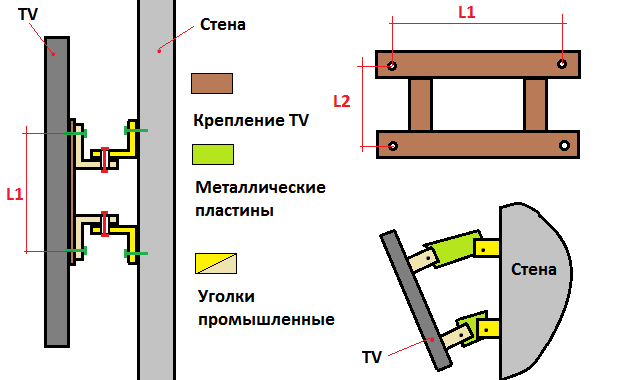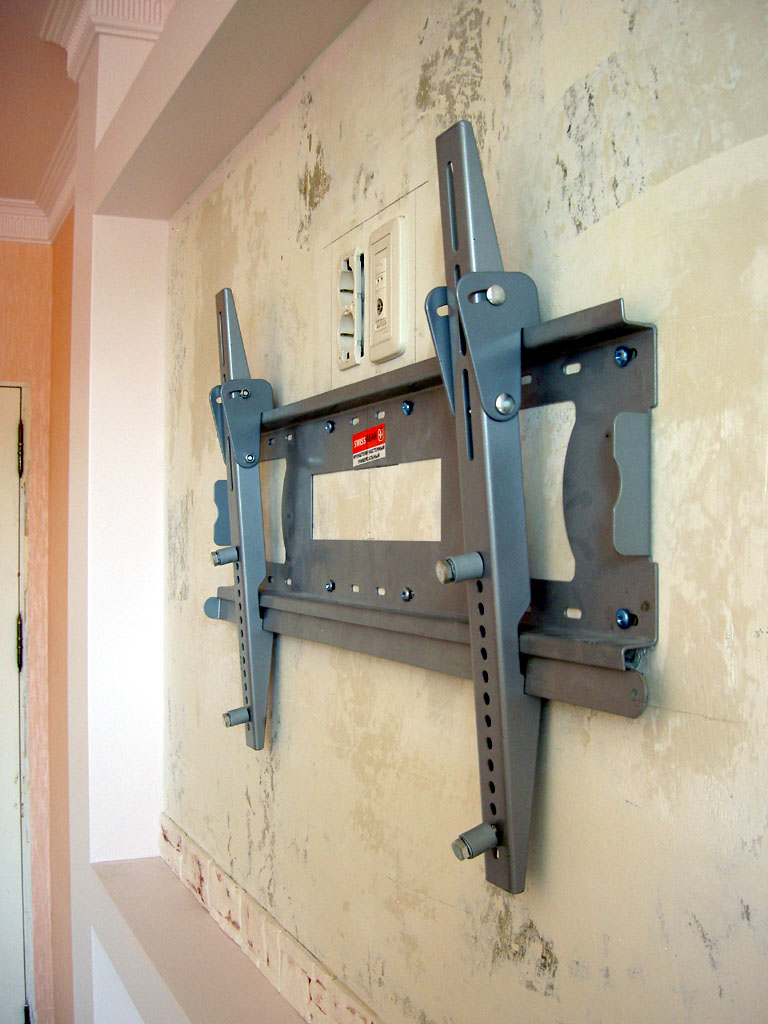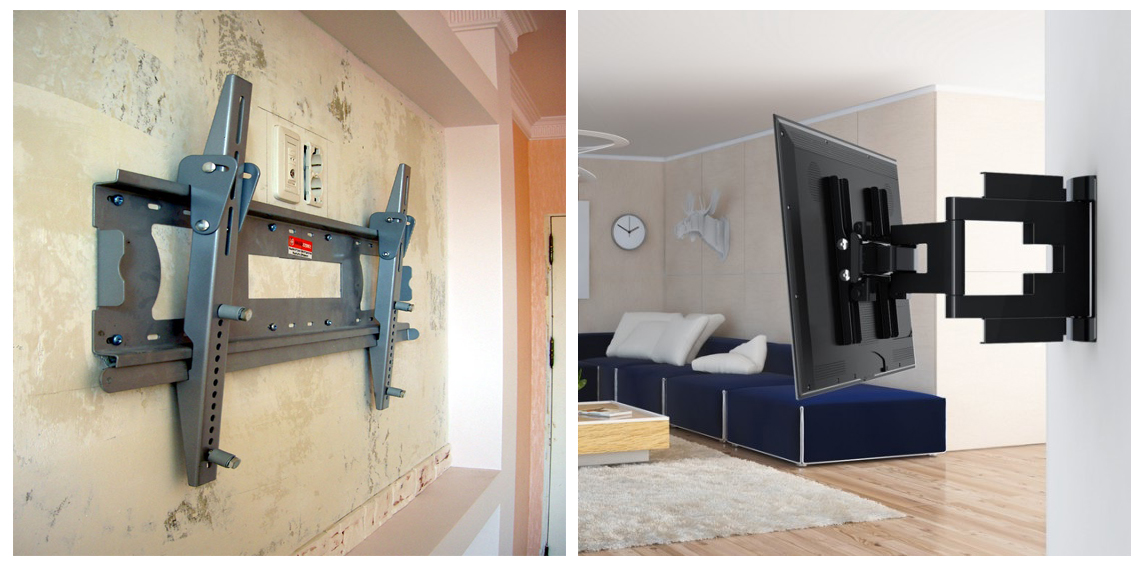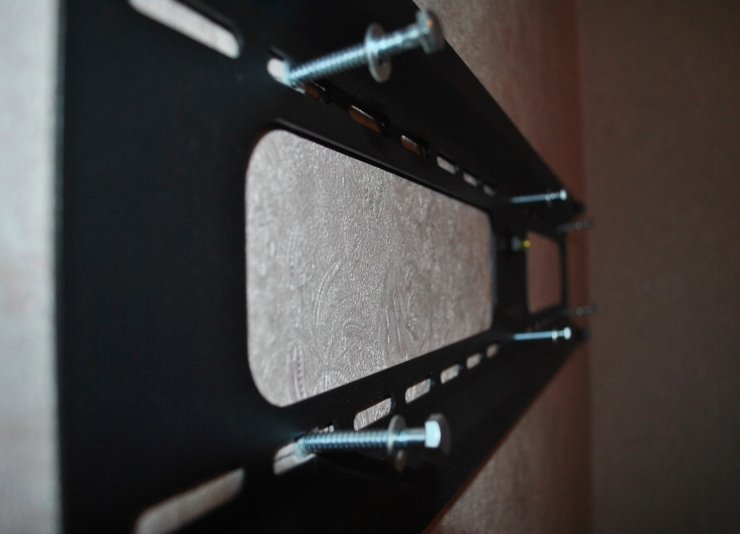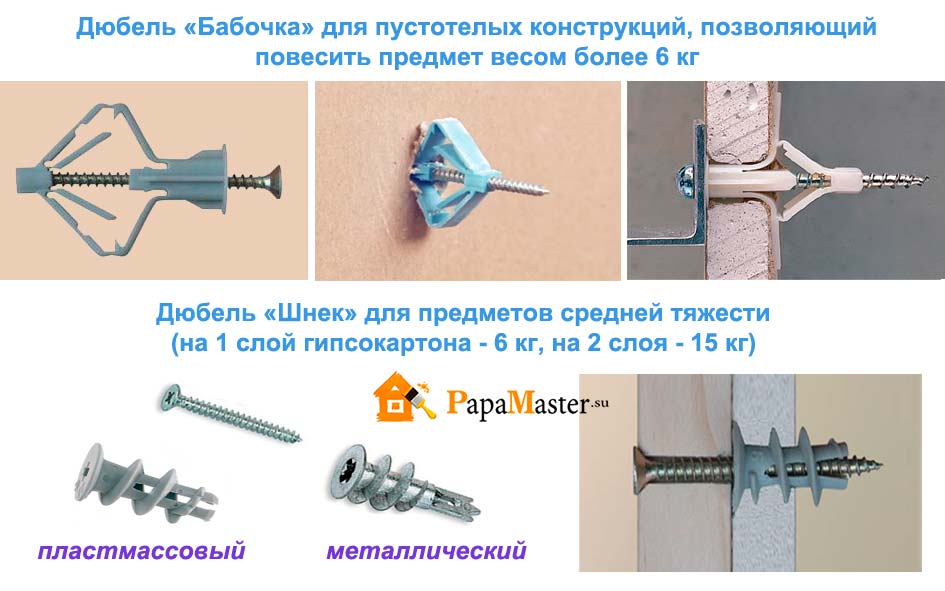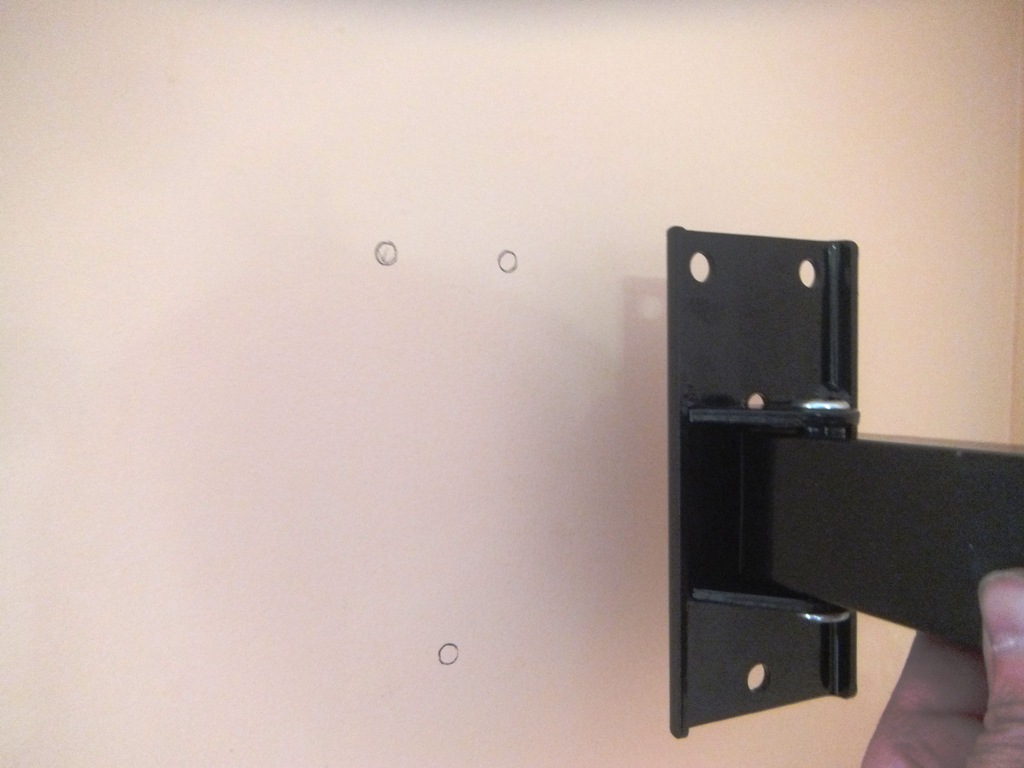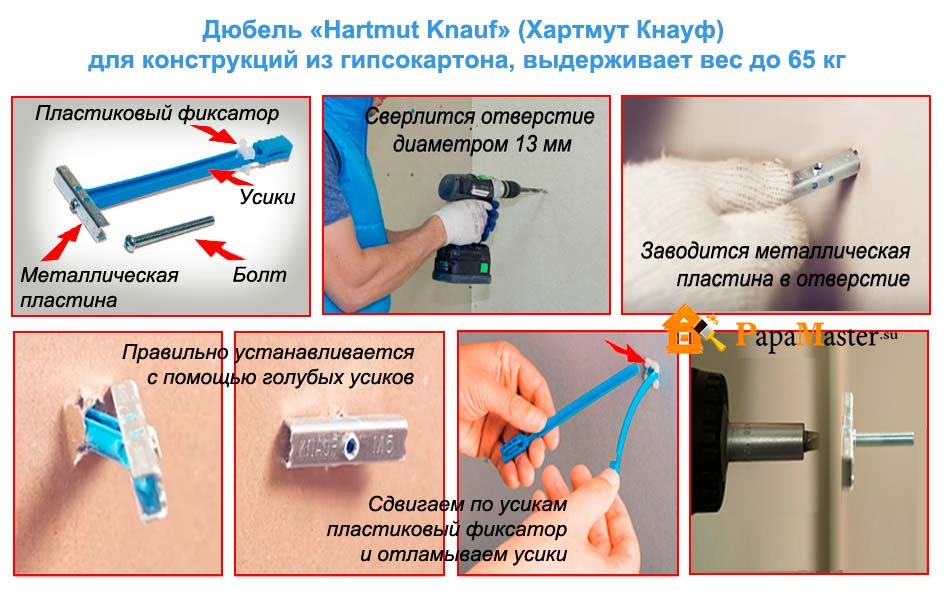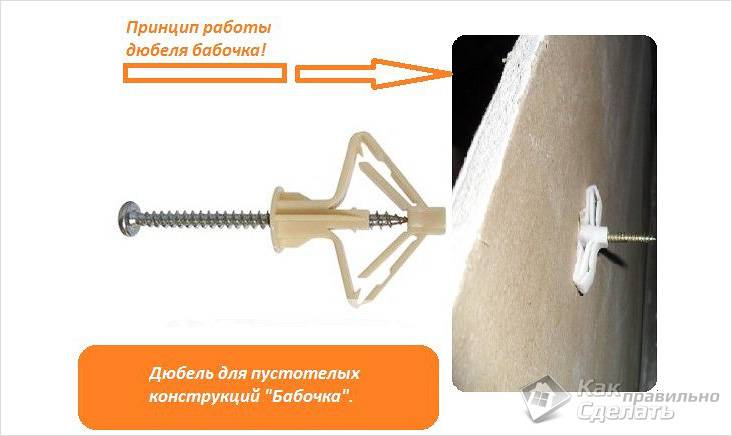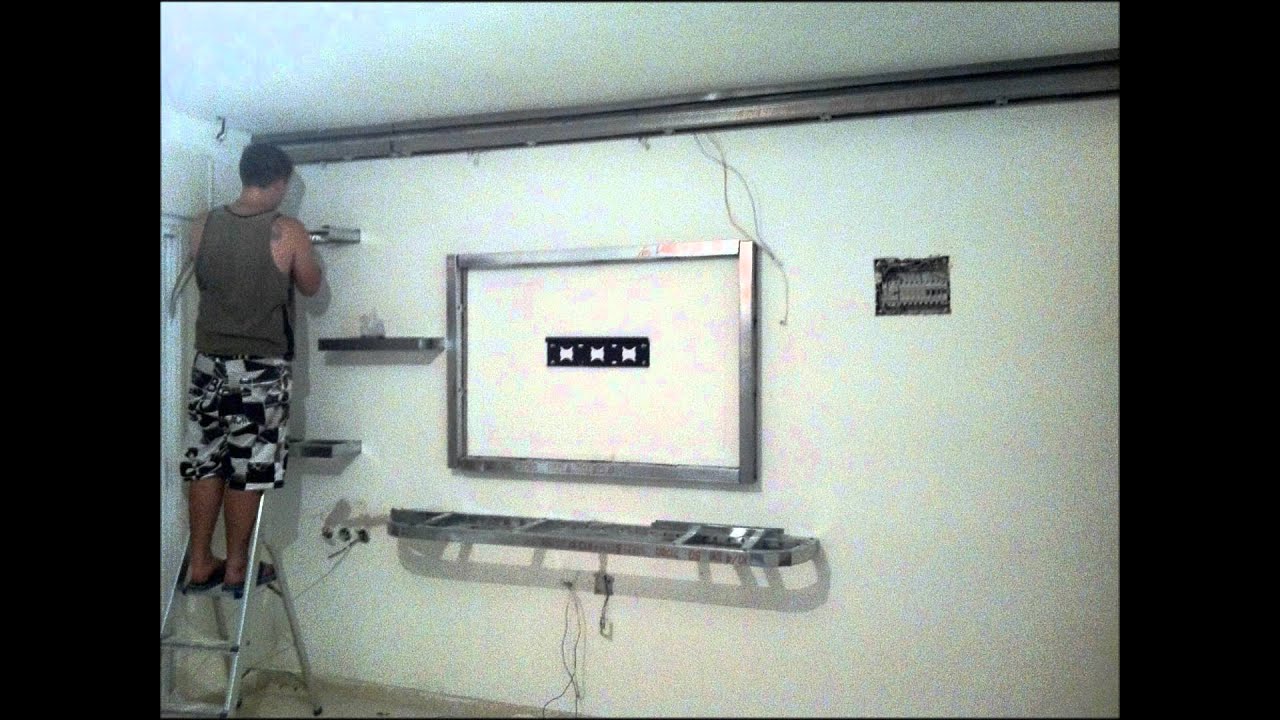Stages of work
The simplest option involves hanging a small-sized TV in the following way:
insert fasteners - butterfly dowels into the previously made holes;
Dowel "butterfly"
- use them to attach a bar with brackets;
- hang up the TV.
Note! Only liquid crystal models with a low weight can be hung in this way. Equipment weight should not exceed 15 kg
Otherwise, the plasterboard wall will begin to collapse.
This method involves installing only well-fixed mounts that do not have the ability to pivot. In this case, the weight of the device is evenly distributed over the outside of the material.
If the TV has a mass greater than 15 kg, then it is mounted on brackets. To do this, you need to do the following operations:
- holes in the drywall should be made in the place where the metal profile is located under it. So you can transfer the main load to the frame;
- we insert special fasteners - anchors into the holes made with our own hands.
Anchor "Molly"
we fix the bracket.
Now you can safely hang your TV on the prepared place in the plasterboard wall.
If the model has a significant enough weight, and in addition to it you still want to install additional equipment (speakers, amplifiers, etc.), you need to make a shelf or niche. In such a situation, you need to install external bearing racks with your own hands. Their installation involves the following actions:
- ⦁ wooden beams or metal pipes, I-beams, channel bars, etc. can be used as load-bearing racks. Be sure to pre-treat the tree with an antiseptic solution.
Note! The main thing is that the selected rack option can withstand the required weight of the device.
- we install the racks vertically along the wall;
- we embed them in the floor in such a way that they do not stagger;
- drywall sheets can be attached to the resulting frame;
- if necessary, we install horizontal shelves in the frame for additional equipment.
 Carrying pillar elements
Carrying pillar elements
To give the racks a proper appearance and bring them in line with the interior of the room, you can use artificial stone, stucco or any other covering for decoration.
If you have a TV with a ray tube, then it will be possible to attach it to the wall either by forming an external support stand, or by using a bracket-sleeve. A niche is absolutely not suitable here, since the parameters of such a model will be too large for it.
Remember! In such a situation, the movable fasteners cannot be used. The swivel-tilt device can create a very large load on the wall due to the presence of a large lever in its design. As a result, the drywall wall will collapse very quickly.
If, nevertheless, you decide to make a swivel-tilt mechanism, then you need:
- fix it with screws;
- fix only on metal profiles, under the gypsum board. Use a magnet to find them;
- the weight of the equipment should not be significant.
As you can see, a TV of almost any weight and size can be installed on a plasterboard wall. You just need to strictly adhere to all the recommendations of specialists. And it is best to foresee in advance the strengthening of the frame structure in the place of future fastening of heavy elements.
How to correctly calculate the profile for drywall
Plasterboard niches for TVs, selection and installation
Bracket mounting
Since it can be difficult to hang a TV on drywall due to the peculiarities of the base, the methods are chosen based on the specific situation. The following mounting options are available:
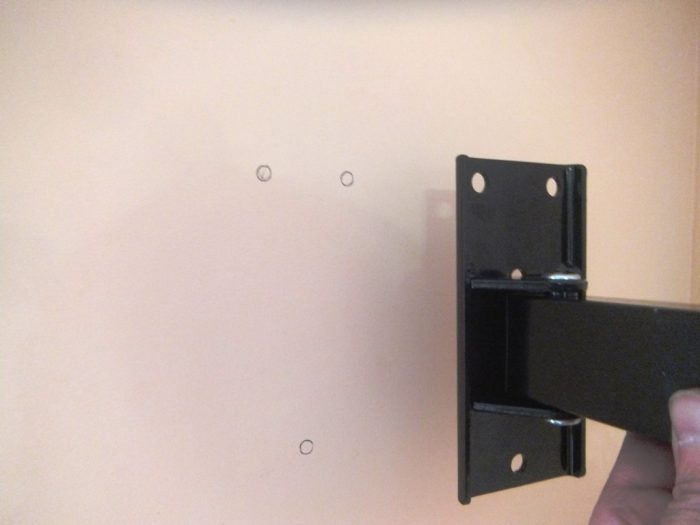
- Fastening directly to the base. This method is acceptable for TVs with small dimensions and weight.
- Installation to the lintel of the cladding frame, if a classic structure made of a metal profile is used.
- Construction of a niche or shelf. This method is often the only way to place equipment of impressive dimensions and weight on the wall.
If the owners of the TV decided on the last option, then it is better for them to know in advance that such a technique will fail them much faster. To a greater extent, this applies to plasma panels that generate more heat. Liquid crystal models are more loyal to imperfect ventilation. Gaps of 200 mm on each side will save a potentially hazardous situation.
Fixing the bracket with dowels
Fasteners for ordinary walls in this case are completely unsuitable. The supplied dowels are intended only for concrete or brick foundations. They cannot be used for a gypsum plasterboard surface: neither for a single-layer, nor for a two-layer. To hang the brackets, buy special dowels for drywall - "butterfly" (TNF / -W), "drive" (Driva, TT-22) or "molly" (Molly, "umbrella"). Their difference from ordinary products is the ability to open and thereby reliably fix the screws in the wall. Each "tricky" fastener has its own characteristics, weight limitation:

- The butterfly is the most popular option. She (he) requires pre-drilling the drywall. The fasteners cannot be called outstanding, but the "insect" will quite cope with the technique of medium weight. One dowel can hold 15 kg on a single-layer wall, about 28 kg on a two-layer base.
- Driva made of metal is the most convenient type of dowels, since you don't even need to drill a drywall sheet. The reverse side of it will also remain safe and sound. For plastic fasteners, this operation is necessary. The permissible load on a plastic product is 25 kg, for a metal product - more than 30 kg.
- Molly is called by many different names: anchor, bolt or dowel. This is a metal heavyweight in this trio, however, it requires pre-drilling the drywall. Special forceps or training will still not interfere, which will help master the skills of opening an umbrella from the back of the gypsum board. This dowel can withstand up to 40 kg, allows for dismantling. Its only drawback is its relatively high price.

Reuse of fasteners containing plastic elements is not recommended. Such dowels no longer guarantee reliable weight retention, so the help of anchors is often required. All of the mounting options presented are suitable for TVs that are not overly heavy.
What should be considered?
The first thing that cannot be replaced in any case is special dowels designed specifically for drywall.
- Even the best fasteners are not yet a guarantee of the reliability of fixing the TV, since the fragile material of the wall itself can fail. Therefore, the best option is a frame sheathed with two layers of gypsum board.
- The best solution is the installation of embedded elements at the stage of creating a plasterboard partition. This method avoids all possible problems.
- After fixing the bracket, it is recommended to check it for strength: the test is carried out with the weight for which it is designed.
- Regular inspection of fasteners is imperative. The first is done in 2-3 weeks, the next - every 4-6 months.
- The fasteners supplied with the bracket must not be used for drywall.
Another point is the height of placing the TV on the wall. For seated viewing, the top edge of the panel should be approximately 1.2 m from the floor. Where there are small children, it is recommended to increase the height to 1.5 m. In other cases, this parameter is unimportant.The optimal viewing distance from the TV is shown in the following table:

It is clear that the advantage is on the side of those owners who were concerned about the question of how to hang the TV on drywall earlier, even before (during) the repair. If the idea came to mind later, then the brackets will have to be fixed "as is": using the frame guides that hold the gypsum board. Or reinforce the structure in any other way.
You can get acquainted with detailed instructions on how to hang a TV on drywall using another super-reliable dowel without leaving us:
Common mistakes
Due to inattentive study of the instructions or lack of practical experience, many make mistakes during the installation process. The list of the most common mistakes includes the following:
- Wrong choice of design. The purchase and installation of a bracket that, according to its technical characteristics, is not capable of withstanding a heavy load, leads to a distortion or fall of the TV.
- Insecure fixation. All fasteners must be screwed into the drilled holes until they stop. Otherwise, they will loosen and fall out.
- Deviation from instructions. By violating the sequence of actions when installing the structure, you can miss important details, which will deteriorate the reliability of fixation.
- Insufficient number of fasteners. During installation, you must use all the fasteners that are included with the canopy.
Choosing a wall location for your TV panel
To choose the optimal location of the "plasma", you need to take into account its size, area and purpose of the room, the strength of the walls.
Distance to monitor
This is one of the most important parameters of correct editing, affecting the comfort of watching TV programs, and stress on the eyes. The distance of a person from a television picture depends on the diagonal of the screen:
- 2.5 meters - with a diagonal of 32 inches (80 cm);
- 3 meters - with a diagonal of 40 inches (100 cm);
- 4 meters - with a diagonal of 55 inches (138 cm) or more.
Therefore, you should not buy too large a TV in a small room, since it will not be possible to provide the necessary distance, and it will be uncomfortable to watch it.
Here, the distance clearly does not match the width of the screen.
Height above the floor
In order for the eyes and neck not to get tired during a long teleselection, an imaginary horizontal line dividing the screen into two equal parts should be just above eye level. It is clear that people have different heights, but absolute accuracy is not required here either. But you need to consider in what position they will watch TV. And it depends on the room in which it is installed.
- Living room. This room usually contains a seating area for the whole family with upholstered furniture. It is best to hang the TV against the wall in front of this area at a height corresponding to the height of a person sitting in an armchair or sofa. Usually it is equal to 120 cm with slight deviations in one direction or another.
- Bedroom. In this room, they watch TV lying or half-sitting in bed. To determine the most comfortable level for your favorite posture, the level of installation of the monitor, you need to take it by hanging a picture or other improvised screen on the opposite wall. Then move it up or down until you find the most comfortable position.
This position of the screen cannot be considered convenient - it is better to hang it higher with a tilt forward
Kitchen. In this room, it is most convenient to install a TV set. As a rule, it is placed opposite the dining area, but ideally it should be visible from the desktop as well. It is not always possible to combine this, especially if you take into account the specifics of a kitchen with a large number of cabinets and household appliances. The monitor should not be placed near an oven, steamer, or other heating or steam generating devices. It should not interfere with free movement, open cabinets.Therefore, most often it is suspended at a decent height - and here again you cannot do without mechanisms that allow you to change the position of the screen.
In the kitchen, you have to sacrifice comfort for safety.
How to hang
Before fixing the TV to the wall, you need to familiarize yourself with how to hang it.
On bracket
Installation on a bracket is quite easy, but you still need to familiarize yourself with a few useful tips in advance:
- before you start hanging the TV, you need to carefully study the wiring plan so as not to accidentally touch it;
- if the TV is too heavy, it is better to hook it with an assistant;
- when installing television equipment, it is necessary to take into account the distance for ventilation so that the television does not overheat.
Without him
Sometimes people are unable to attach the TV to the brackets and have to do it without them.
In this case, you will have to build the fastening system yourself. To create it, you will need to prepare two pieces of cut wood in advance. To do this, a block of wood is cut into two equal parts using a circular saw. One of the pieces of wood is attached to the back of the TV, and the other to the wall. When installing the TV, wooden blocks are fastened with screws.

Bracket selection
When figuring out how to hang a TV on a wall with a bracket, you must first determine which bracket will be used. They are available in two types, universal or specialized.
Universal models are suitable for TVs of different brands and sizes, have a relatively large tolerance for the weight of equipment and either several holes for fastening to the panel, or "floating" hinges.
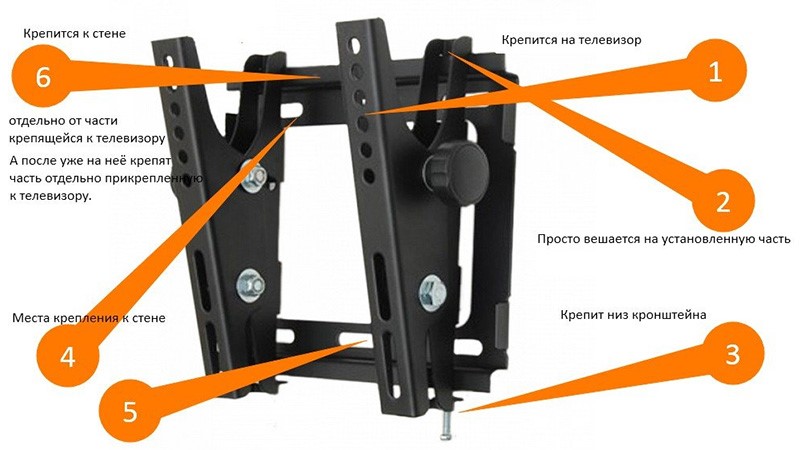
In the proposed photo, a number of holes are intended for fastening, and the fragments themselves with these holes can move and move apart along the guides, depending on the location of the mounting "mating" holes on the back of the TV.

In brackets with "butterfly" fastening, the holes cannot be located in one or two rows - they are made in groups.

Regardless of the type of product, the presence of FOUR or more attachment points is required - with a smaller number, the risk of destruction of the plastic case of the equipment in the fixation points is too great.
An interesting point: many universal brackets are equipped with a built-in level to accurately align the product horizontally during installation. Where there is no such detail, you will have to use the usual level for marking.
Dedicated brackets fit only one model or lineup, or only one manufacturer's models. For expensive equipment, such products are often included in the delivery set.
Types of brackets:
- for fixed mounting. They do not allow to move the TV in any way, provide rigid fixation in the selected position. Usually the panel is placed horizontally, as close to the wall as possible, or at an angle. You can change the slope only when the equipment is removed from the mounts;
- inclined, makes it possible to change the position of the screen. Usually, the permissible angle does not exceed 20 degrees;
- swivel - the screen can be moved vertically and horizontally;
- retractable - makes it possible to push the equipment forward or move it closer to the wall;
- combined. Swivel-tilt, swivel-retractable. As the name implies, it gives freedom of movement in two or three directions.
How to hang a TV on drywall?
The lightest TV models do not need serious reinforcement: the frame elements, as well as drywall fasteners, will cope with the task. Dimensional devices require a different approach. If the weight is light, then the work itself will not take much time.

First, they look for metal guides on the wall. The operation is performed using a magnet, some craftsmen recommend "arm" with a metal detector. Place marks in the area of greater attraction.After the target is found, mark the place for the bracket, always use a level for ideal placement.
- A bracket is applied to this place (it is better to act together with an assistant), the correct location is checked - horizontality.
- Marks are made with a pencil through the holes for fastenings on the wall, then the structure is set aside. The greater the weight of the instrument and the bracket, the more perimeter fixings are required.
- Holes are drilled at the marked points. Their diameter is exactly the same as that of the dowels. The latter should be difficult to enter. Be sure to make sure that the holes are perpendicular to the wall. Dowels are inserted into them.
- They are pushed to the end, then pry off with a knife (or screwdriver), forcing the dowels to open. Take the bracket again, apply the plate to the wall, then screw in the screws. Do not tighten them too much.
- The TV is laid with the screen down on a hard surface, guides are applied to the holes, which are fixed with self-tapping screws from the kit. They are twisted especially carefully.

The TV is fixed to the structure, following the manufacturer's instructions. If the drywall is close to the concrete base, you can choose another method. In this case, long dowels are used, drilling holes through the gypsum board. However, this method is not as reliable, so it is best not to use it if possible.
Attaching the bracket to a plasterboard wall
It is not always easy to install the holding devices, much depends on the surface characteristics. There are different methods, selected for a specific situation.
With dowels
The fixing of heavy objects on plasterboard bases is carried out only if correctly selected fasteners. It is not allowed to use ordinary self-tapping screws, which are screwed into a single-layer or double-layer surface. To hang the bracket, a molly, butterfly or driva dowel is used. It is taken into account that each variety has certain weight restrictions.
 Special fasteners for mounting heavy objects on drywall
Special fasteners for mounting heavy objects on drywall
Process algorithm:
The most suitable installation location is selected. For this, the location of interior items is analyzed from the point of view of the convenience of visual perception. This is especially true when using a stationary mechanism.
It is important to consider the location of natural and artificial light sources that may interfere with viewing.
The best option is to fix the mechanism to rack profiles or jumpers. This will make the commit more secure.
The mounting platform of the bracket is applied to the selected location, leveling is performed using a level, after which the attachment points are marked
Holes are drilled according to the diameter of the dowel sleeve. You can't make the hole bigger, then you won't be able to tighten the screws tightly.
The main part of the dowel is placed in the seat and, if necessary, knocked out a little with a hammer.
The mounting holes in the wall and on the bracket are aligned, screws are screwed in successively
With a small size of the cap, a washer must be laid.
The mechanism must be fastened carefully: it is held until all the screws are tightened. After that, you can hang up and connect the equipment.
The reliability of fixation is checked
Do not let loose or sag.
This method is recommended for installing equipment weighing less than 25 kg. To fix the TV on a plasterboard wall with a greater mass, it is required to use anchors, the mounting hole for which is created not only in the gypsum board, but also in the base.
 Through fastening is considered one of the most effective methods of suspension, but it can only be used if the distance from the load-bearing wall to the front side of the drywall does not exceed 100 mm
Through fastening is considered one of the most effective methods of suspension, but it can only be used if the distance from the load-bearing wall to the front side of the drywall does not exceed 100 mm
Through mortgages
This is the best solution, especially if you need to hang a heavy structure. The method also provides reliability when fixing mechanisms with protruding rotary elements.
Mortgages are included in the list of mandatory parts when creating niches for installing a TV and equipment and arranging an interior partition.
Fastening technology:
- Depending on the configuration of the embedded part, suitable self-tapping screws are selected. Most often, a wooden bar is used for insertion into the frame, but there are options in which it is placed in a pre-assembled lintel from a profile. In such a situation, reaming of the metal part will be required.
- According to the lathing scheme and the location of the holes on the mounting sections of the bracket, marking is carried out. When working, it is necessary to use a level to adjust the placement of the hitch.
- To avoid damaging the drywall, anchoring points are pre-formed.
- It is also recommended to drill out wooden beams. For this, a nozzle with a diameter smaller than the shaft of the selected screw is used. This avoids cracking of the embedded material, especially if the material is overdried.
- According to the mounting points, a bracket is exposed and cured by several self-tapping screws with a washer. The necessary adjustments and final fixation are made.
This technology allows even heavy TVs to be attached to the retractable and swivel mechanism.
 Methods for arranging TV mortgages
Methods for arranging TV mortgages
Materials and tools
Before starting work on installing television equipment on a partition made of fragile material without reinforcing the frame, it is important to take care of the availability of the necessary tools. Be sure to have a drill to drill holes
A hammer drill is needed if it is necessary to drill a concrete wall to attach a bar or profile.


You will also need a screwdriver and dowels of the following types:
- "butterfly";
- "umbrella";
- Hartmut.

Such products are made specifically for hollow structures, they expand inside them, which is the fixation. They are disposable. Repeated use loses the strength of the fastener and it may not support the weight. In some situations, there is a need to use anchors.
In the case of using embedded amplifiers, wooden blocks must be available. Parts should have a square cross section, and the sides should be 50 mm. Metal corners will also come in handy.

To fix the device on a drywall plane with your own hands, you will need:
- drill;
- drill;
- a screwdriver, if it is not there, then you will have to work with a screwdriver;
- pencil and level for marking;
- roulette.

From accessories and material you need to purchase:
- a variety of screws, bolts, dowels or anchors;
- wooden blocks;
- brackets, if not included with the device;
- metal corners.
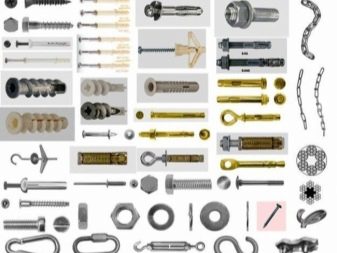

If all this is available, then the work will go easily and smoothly without the help of specialists and will not require additional time due to the lack of one or another subject.

